NETIS SYSTEMS 320GP2006M1 Wireless PCI Adapter User Manual
NETIS SYSTEMS CO., LTD. Wireless PCI Adapter
Users Manual

Wireless network adapter User manual
Page 1 of 27
Wireless Network Adapter
User’s Manual

Wireless network adapter User manual
Page 2 of 27
Table of Contents
Contents of Package:...............................................................................3
Before you begin .....................................................................................4
Chapter 1 Introduction............................................................................4
1.1 Welcome ...................................................................................................................................4
1.2 About This Guide......................................................................................................................5
1.3 Copyright statement..................................................................................................................5
Chapter 2 Hardware Description .............................................................5
2.1 Cardbus adapter.........................................................................................................................6
2.2 PCI adapter................................................................................................................................6
Chapter 3 Hardware Installation .............................................................7
3.1 Before you begin.......................................................................................................................7
3.2 Cardbus Adapter: ......................................................................................................................7
3.3 PCI Adapter: .............................................................................................................................7
Chapter 4 Install Driver...........................................................................8
4.1 Windows 98SE, Me and 2000...................................................................................................8
4.2 Windows XP ........................................................................................................................... 11
Chapter 5 Install Driver Install Utility ...................................................13
Chapter 5 Configuration your wireless adapter .....................................15
Chapter 6 Using the Wireless Client Configuration Utility......................17
6.1 Network Status........................................................................................................................17
6.2 Site Survey.............................................................................................................................. 18
6.3 Admin......................................................................................................................................19
6.4 Profile Manager.......................................................................................................................21
Chapter 7 Troubleshooting ....................................................................25
APPENDIX A Specifications....................................................................26

Wireless network adapter User manual
Page 3 of 27
This device complies with Part 15 of the FCC Rules. Operation is
subject to the following two conditions:
(1) This device may not cause harmful interference.
(2) This device must accept any interference received, including
interference that may cause undesired operation.
This equipment has been tested and found to comply with the limits for a class B digital device,
pursuant to part 15 of the FCC Rules. These limits are designed to provide reasonable protection
against harmful interference in a residential installation.
This equipment generates, uses and can radiate radio frequency energy and, if not installed and
used in accordance with the instructions, may cause harmful interference to radio communications.
However, there is no guarantee that interference will not occur in a particular installation. If this
equipment does cause harmful interference to radio or television reception, which can be
determined by turning the equipment off and on, the user is encouraged to try to correct the
interference by one or more of the following measures:
---Reorient or relocate the receiving antenna.
---Increase the separation between the equipment and receiver.
---Connect the equipment into an outlet on a circuit different from that to which the receiver is
connected.
---Consult the dealer or an experienced radio/TV technician for help.
Changes or modifications not expressly approved by the party responsible for compliance
could void the user's authority to operate the equipment.
FCC RF Radiation Exposure Statement: This equipment complies with FCC RF radiation
exposure limits set forth for an uncontrolled environment. This device and its antenna must
not be co-located or operating in conjunction with any other antenna or transmitter.
Contents of Package:
z Wireless network Cardbus/PCI adapter
z Manual, Drivers and Utility on CD
z Quick Installation Guide
If any of the above items are missing, please contact your reseller.

Wireless network adapter User manual
Page 4 of 27
Before you begin
You must have at least the following:
z A laptop computer/desktop PC with an available 32-bit Cardbus/PCI slot
z At least a 300MHz processor and 32MB of memory
z Windows 98SE, ME, 2000, XP
z A CD-ROM Drive
z Cardbus/PCI controller properly installed and working in the laptop computer
z An 802.11g or 802.11b Access Point (for infrastructure Mode) or another 802.11g or
802.11b wireless adapter (for Ad-Hoc; Peer-to-Peer networking mode.)
Chapter 1 Introduction
1.1 Welcome
The Wireless Network Adapter is a powerful 32-bit Cardbus/PCI Adapter that
installs quickly and easily into PCs. The Adapter can be used in Ad-Hoc mode to
connect directly with other cards for peer-to-peer file sharing or in Infrastructure
mode to connect with a wireless access point or router for access to the Internet
in your office or home network.
The Wireless Cardbus/PCI Adapter connects you with 802.11g networks at up to
an incredible 54Mbps! And for added versatility, it can also interoperate with all
the up to 11Mbps 802.11b products found in homes, businesses, and public
wireless hotspots around the country. And in either mode, your wireless
communications are protected by industrial-strength WPA, so your data stays
secure.

Wireless network adapter User manual
Page 5 of 27
1.2 About This Guide
This User Manual contains information on how to install and configure your Wireless
Broadband Router to get your network started accessing the Internet. It will guide you
through the correct configuration steps to get your device up and running.
Note and Caution in this manual are highlighted with graphics as below to indicate
important information.
Contains related information that corresponds to a topic.
Note
Represents essential steps, actions, or messages that should not be ignored.
Caution
1.3 Copyright statement
No part of this publication may be reproduced, stored in a retrieval system, or transmitted
in any form or by any means, whether electronic, mechanical, photocopying, recording, or
otherwise without the prior writing of the publisher.
Chapter 2 Hardware Description
The wireless Cardbus/PCI Adapter supports up to 54 Mbps connections. This card is fully compliant
with the specifications defined in IEEE802.11g standard. It is designed to complement PCI Local Bus
computers and supports Windows 98SE/Me/2000/XP.
2.1 Cardbus adapter
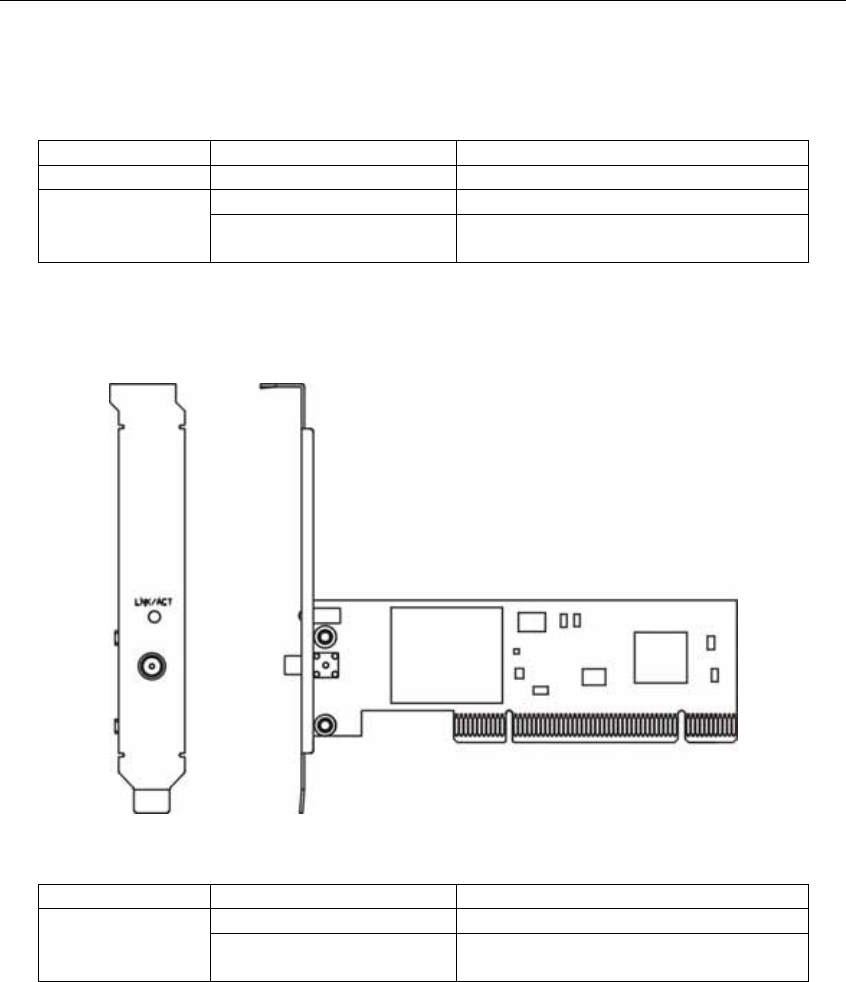
Wireless network adapter User manual
Page 6 of 27
Figure 1-1
LEDs
The two status LED indicators of the Cardbus wireless adapter are described in the following
figure and table.
LED Status Description
PWR ON (Green) Indicates the Adapter is ready
ON (Green) Indicates a valid connection Lnk/Act Flashing Indicates the the Adapter is transmitting
or receiving data.
2.2 PCI adapter
Figure 1-2
LEDs
The Wireless PCI Adapter includes a status LED indicators, as described in the following table.
LED Status Description
ON (Green) Indicates a valid connection Lnk/Act Flashing Indicates the Adapter is transmitting or
receiving data.
Chapter 3 Hardware Installation
3.1 Before you begin
You must have at least the following:
9 A laptop computer/desktop PC with an available 32-bit Cardbus/PCI slot
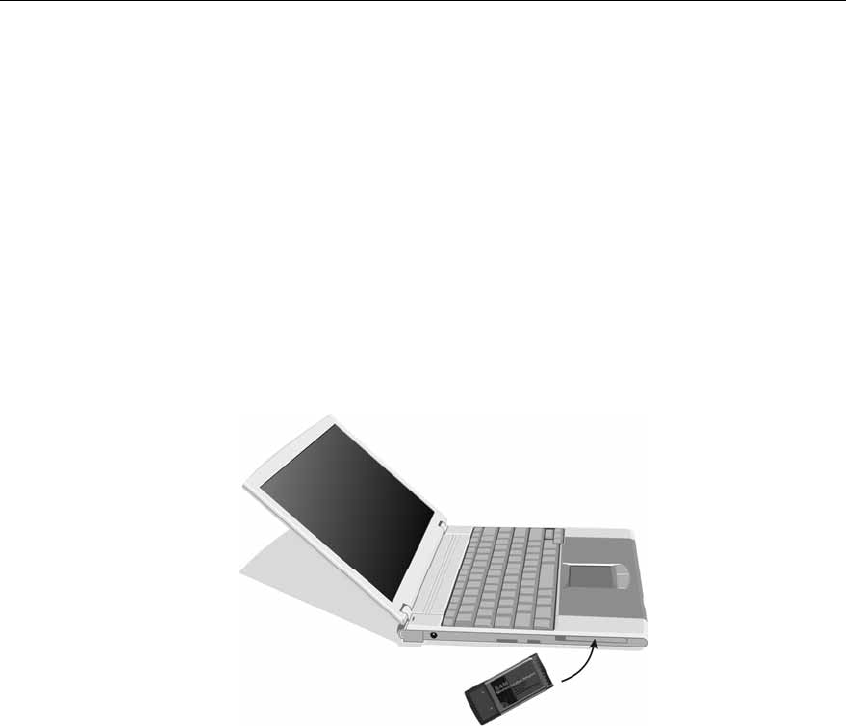
Wireless network adapter User manual
Page 7 of 27
9 At least a 300MHz processor and 32MB of memory
9 Cardbus/PCI controller properly installed and working in the computer
9 A CD-ROM Drive
9 An 802.11g or 802.11b Access Point (for infrastructure Mode) or another
802.11g or 802.11b wireless adapter (for Ad-Hoc; Peer-to-Peer networking
mode.)
3.2 Cardbus Adapter:
Power on your notebook, let the operating system boot up completely, and log in
as needed.
Hold the dapter with the LOGO facing up and insert it into a Cardbus slot. After a
short delay, the Found New Hardware Wizard displays.
Figure 1-1
3.3 PCI Adapter:
Turn off your desktop PC.
Open your PC case and locate an available PCI on the motherboard.
Slide the PCI Adapter into the PCI slot. Make sure that all of its pins are touching
the slot’s contacts. You may have to apply a bit of pressure to slide the adapter
all the way in. after the adapter is firmly in place, secure its fastening tab to your
PC’s chassis with a mounting screw. Then close your PC.
Attach the external antenna to the adapter’s antenna port.
Power on your desktop PC.
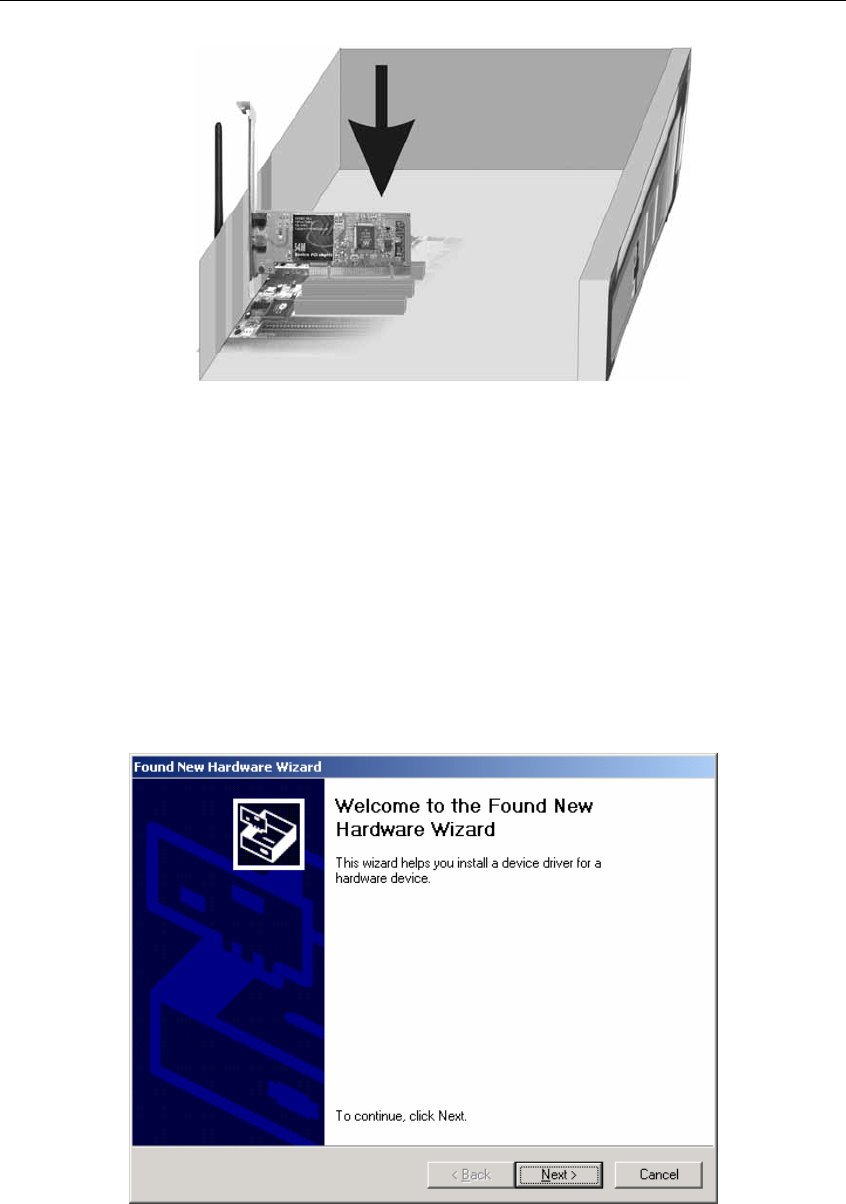
Wireless network adapter User manual
Page 8 of 27
Figure 1-2
You have now completed the hardware installation for the Adapter.
Chapter 4 Install Driver
4.1 Windows 98SE, Me and 2000
Please follow the steps below to install driver:
1. Windows will automatically detect the Adapter. The screen in Figure 2-1 should appear.
Then click the Next button.
Figure 2-1
2. Click the radio button Search for suitable driver for my device(recommended). Then
click the Next button.
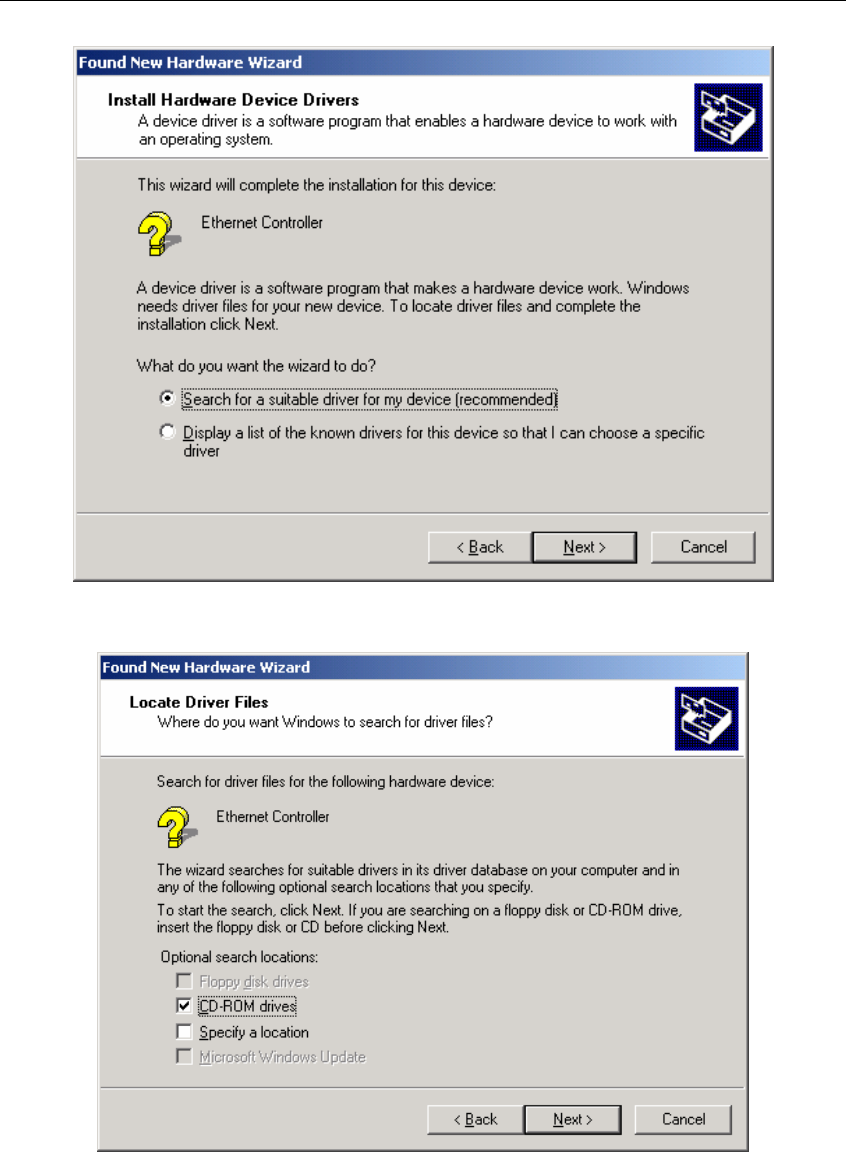
Wireless network adapter User manual
Page 9 of 27
Figure 2-2-
3. Insert the Driver and Utility CD-ROM into the CD-ROM drive.
4. Choose the CD-ROM drives, Then click the Next button.
Figure 2-3
5. Windows find the adapter drivers, then click the Next button.
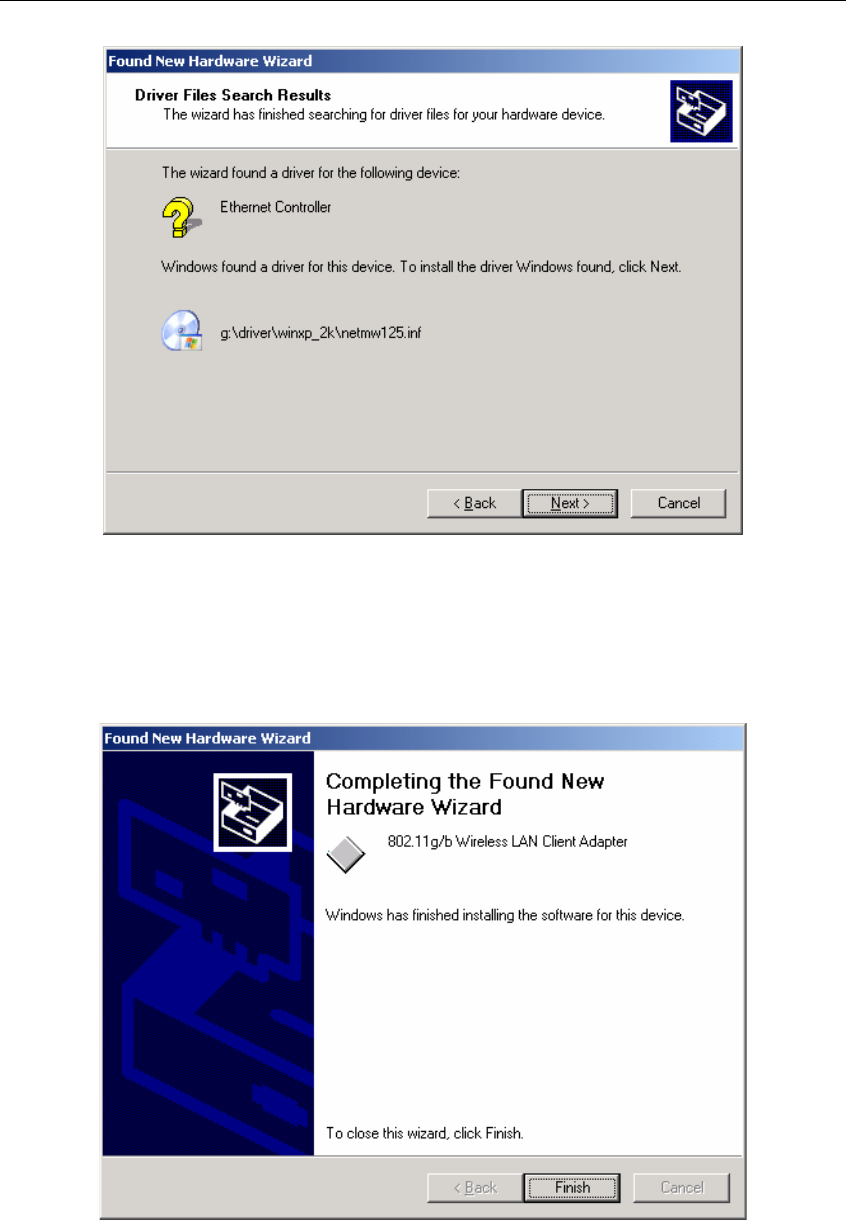
Wireless network adapter User manual
Page 10 of 27
Figure 2-4-
6. click the Finish button, You have now completed the driver installation for the adapter.
Figure 2-5
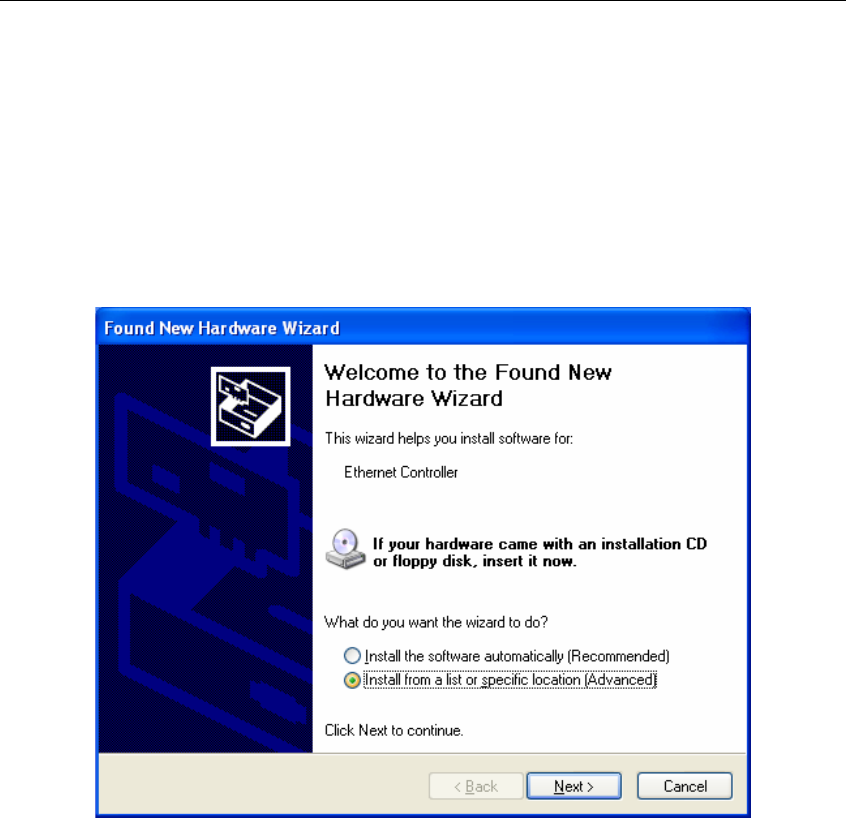
Wireless network adapter User manual
Page 11 of 27
4.2 Windows XP
Please follow the steps below to install your adapter driver:
1. Windows XP will automatically detect the Adapter. The screen in Figure 2-6 should
appear. Click the radio button next install from a list or specific location (Advanced).
Then click the Next button.
Figure 2-6
2. Insert the Driver and Utility CD-ROM into the CD-ROM drive.
3. Choose Search removable media (floppy, CD-ROM…), then click the Next button.
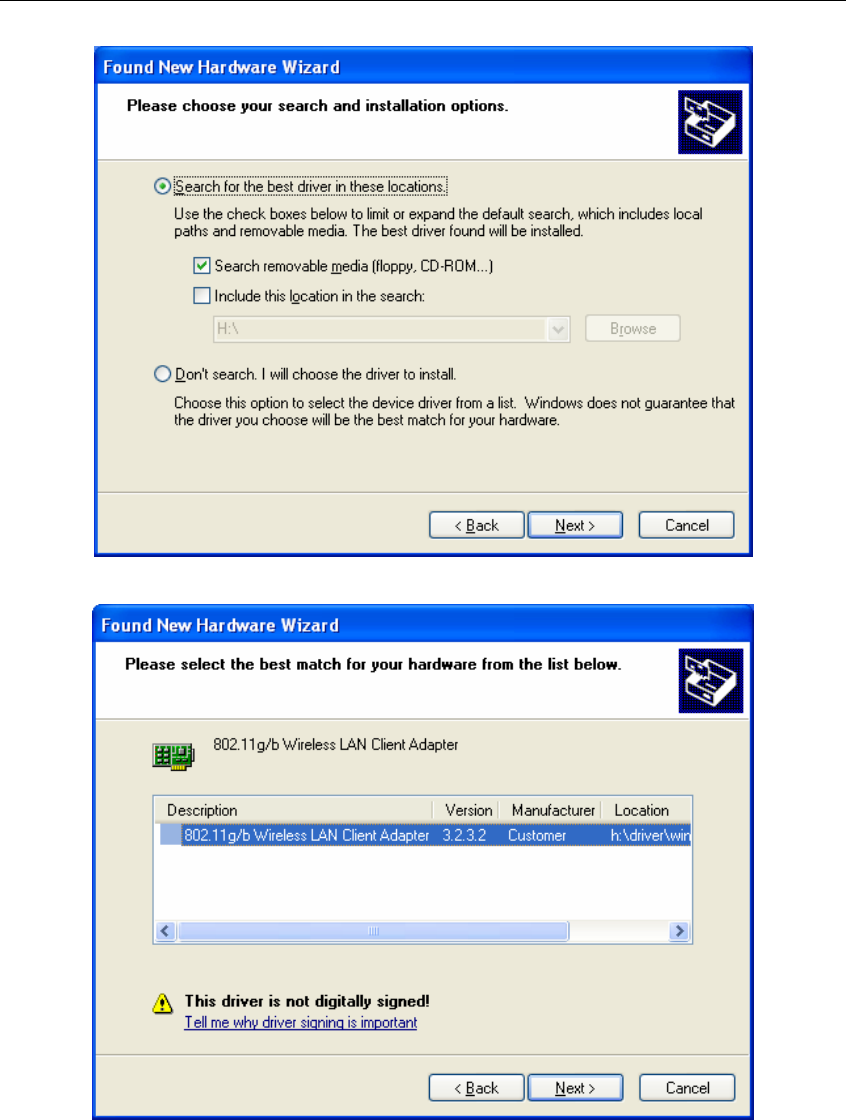
Wireless network adapter User manual
Page 12 of 27
Figure 2-7
4. Windows find the driver from the CD-ROM, then click the Next button.
Figure 2-8
5. Then click Finish. You have now completed the driver installation for the adapter.
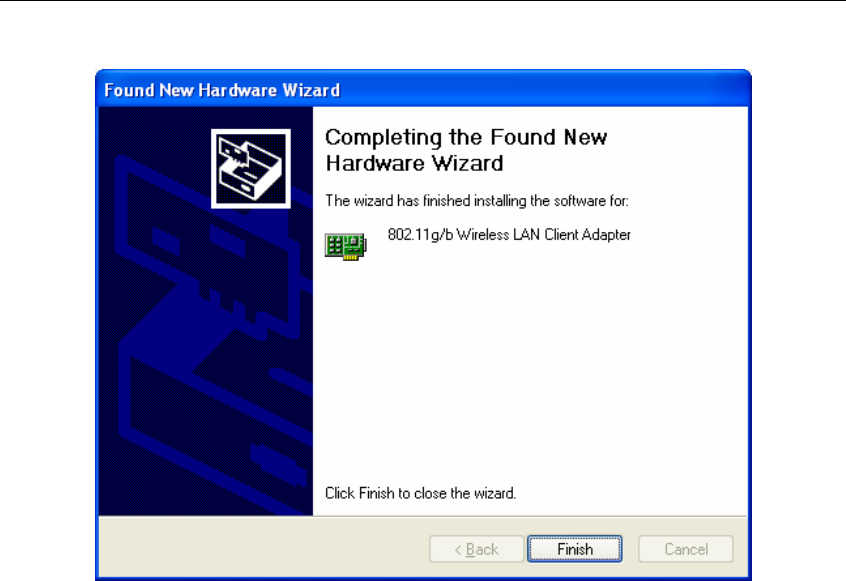
Wireless network adapter User manual
Page 13 of 27
Figure 2-9
Chapter 5 Install Driver Install Utility
1. insert the Driver and Utility CD-ROM into the CD-ROM drive.
2. The Wizard should run automatically, and Figure 3-1 should appear. If it dose not, click
the Start button and choose Run. In the field that appears, enter D:\autorun.exe (if ‘’D’’
is the letter of your CD-ROM drive).
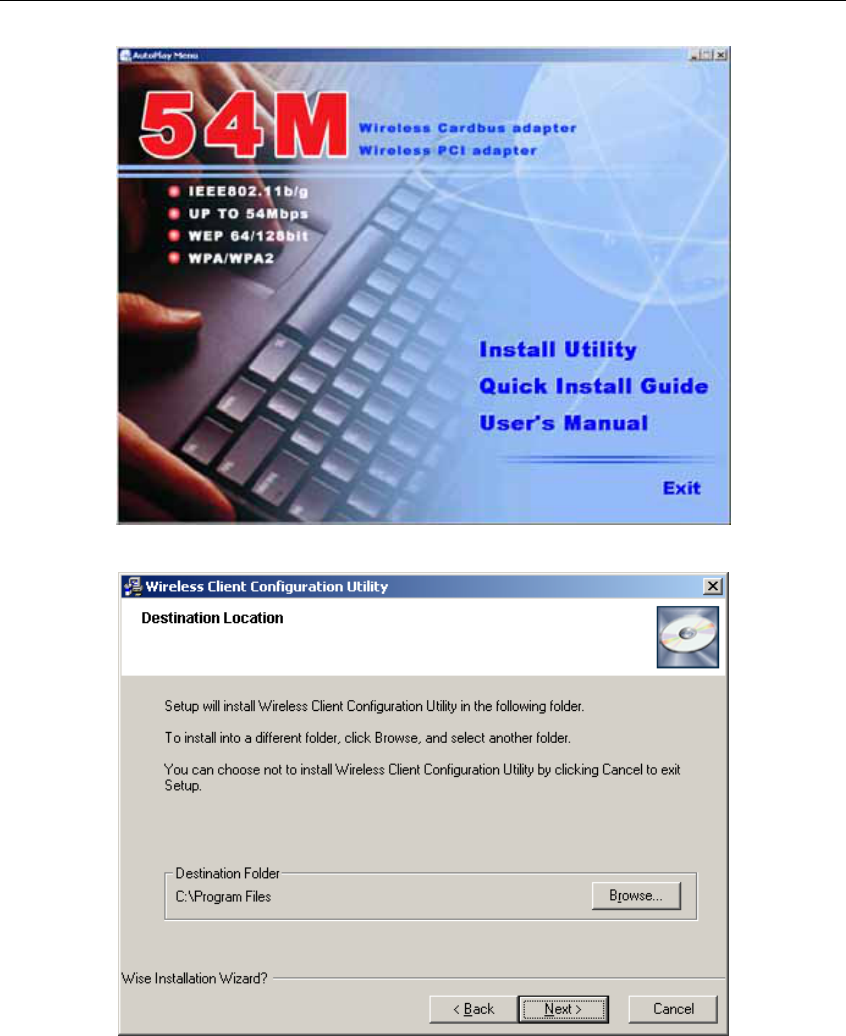
Wireless network adapter User manual
Page 14 of 27
Figure 3-1
3. Click Install Utility on the Wireless Client Configuration Utility screen.
Figure 3-2
4. Follow the Install Shield Wizard steps, and click Finish when done.
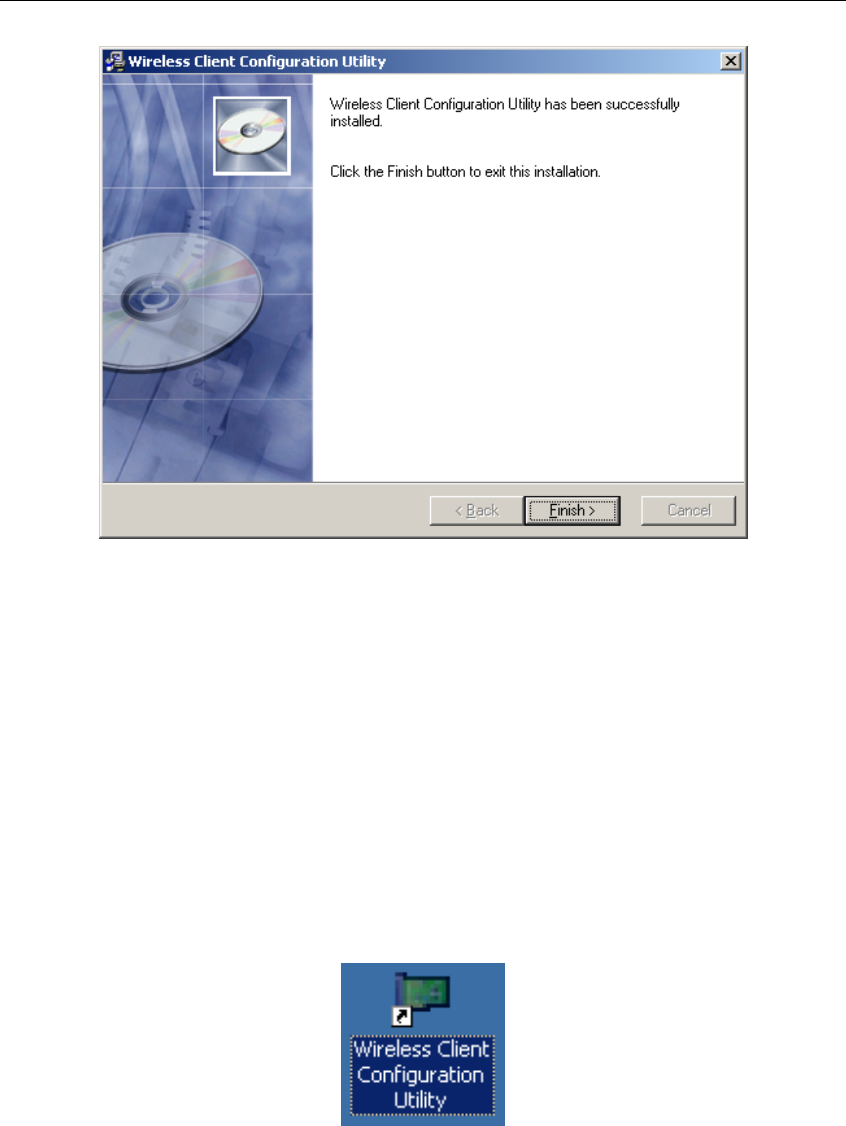
Wireless network adapter User manual
Page 15 of 27
Figure 3-3
Chapter 5 Configuration your wireless
adapter
1. After install the Utility Wireless Client Configuration Utility icon will appear in your
system desktop. Double-click the icon (see Figure 4-1)
Figure 4-1
2. The Wireless Client Configuration Utility screen (Figure 4-2) will appear.
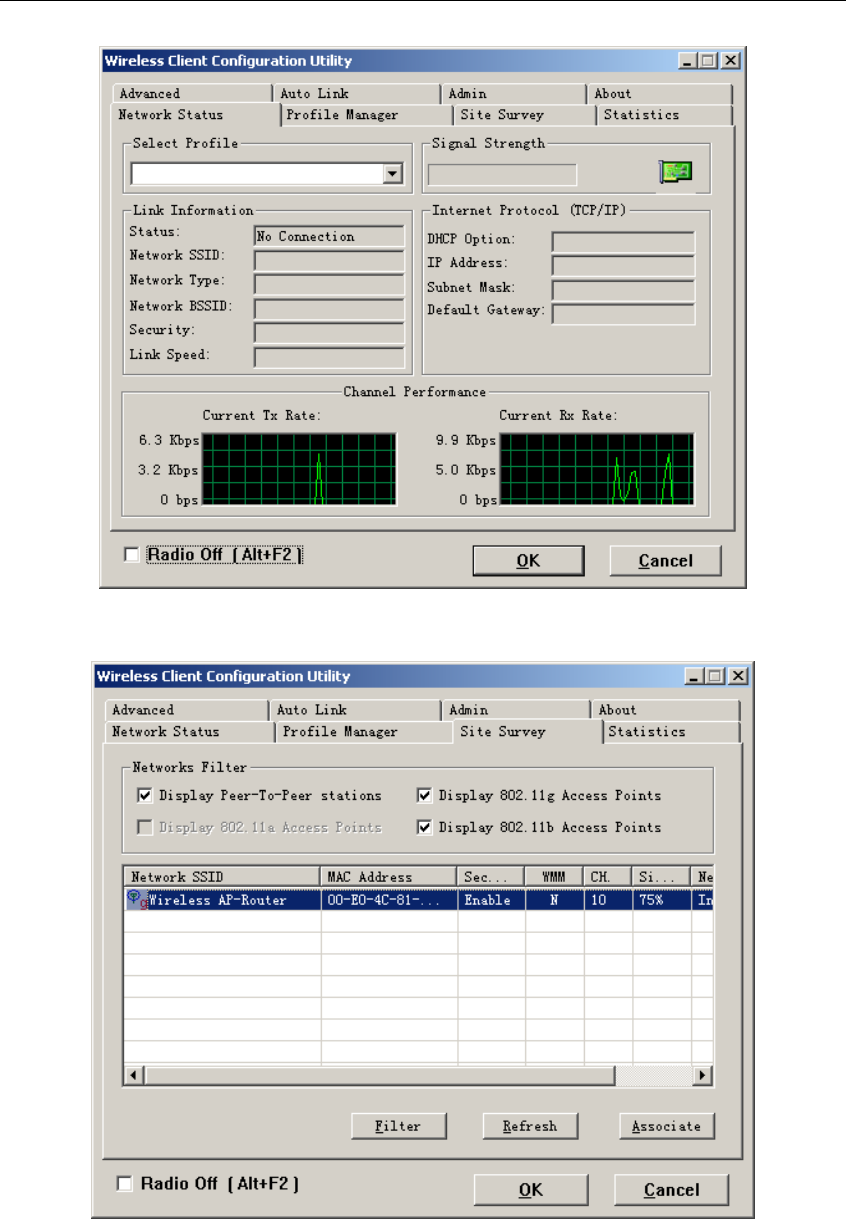
Wireless network adapter User manual
Page 16 of 27
Figure 4-2
3. Click the Site Survey tab, then click the Refresh button to search for available
wireless networks (Figure 4-3)
Figure 4-3
4. To connect to one of the networks on the list, select the wireless network, and click
Associate button.
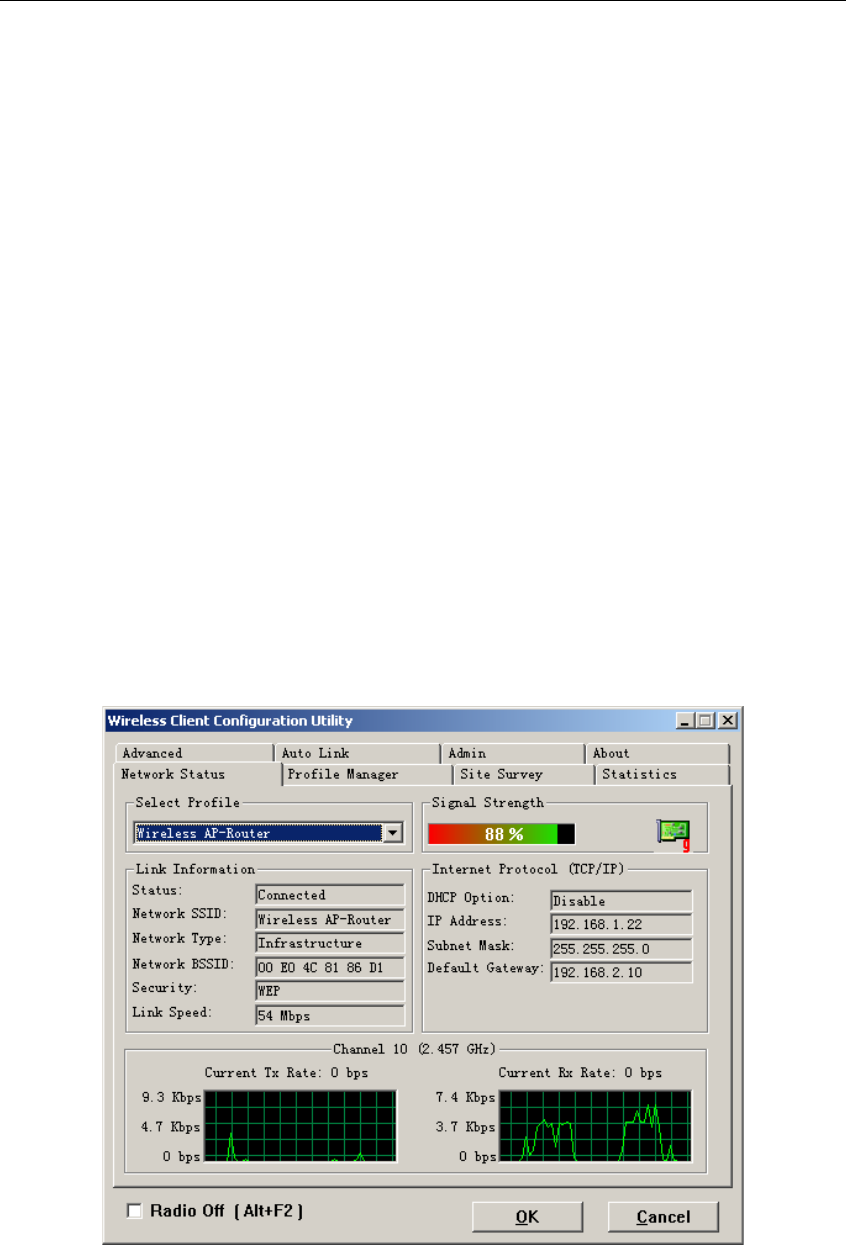
Wireless network adapter User manual
Page 17 of 27
Chapter 6 Using the Wireless Client
Configuration Utility
Use the Wireless Client Configuration Utility to check the link information, search for
available wireless networks, or create profiles that hold different configuration settings.
You can double-click the icon on your system desktop start it. Another way to start the
Configuration Utility is to click on Start>Programs>Wireless Client Configuration
Utility>WirelessCfg.
If you are using Windows XP, you can use either the Zero Configuration Utility or the
Wireless Client Configuration
6.1 Network Status
The Network Status tab displays signal strength and link information, Internet Protocol (TCP/IP).
Figure 6-1
1. Link Information
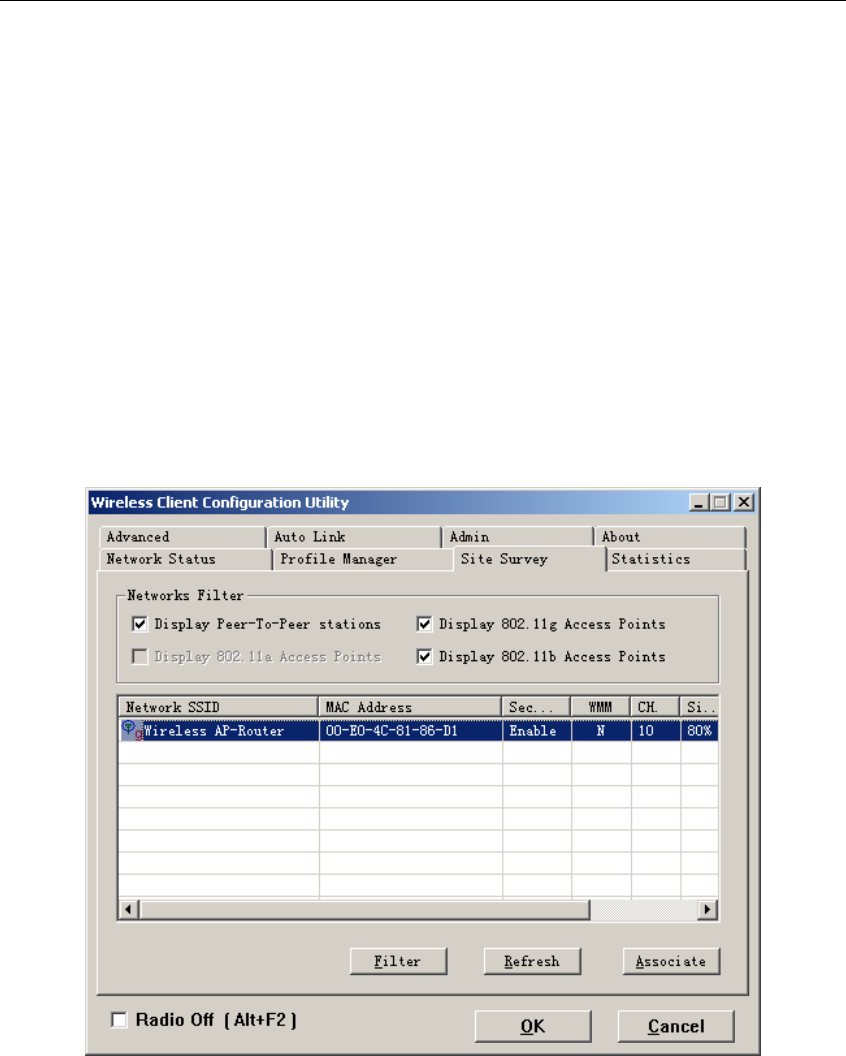
Wireless network adapter User manual
Page 18 of 27
z Status: The status of the wireless network connection.
z Network SSID: The unique name of the wireless network.
z Network Type: The mode of the wireless network currently in use.
z Network BSSID: The MAC address of the wireless network’s access point.
z Security: The status of the encryption security feature.
z Link Speed: The data transfer rate of the current connection.
z Channel: The channel to which the wireless network devices are set.
2. Internet Protocol (TCP/IP)
z DHCP Option: The status of the DHCP client.
z IP Address: The IP Address of the Adapter.
z Subnet Mask: The Subnet Mask of the Adapter.
z Default Gateway: The Default Gateway address of the Adapter.
6.2 Site Survey
The Site Survey tab (Figure 6-2), displays a list of infrastructure and ad-hoc networks available for
connection.
Figure 6-2
The section of the window displays the Available Networks. Highlight the network to which you wish
to connect. Click on the Associate button.
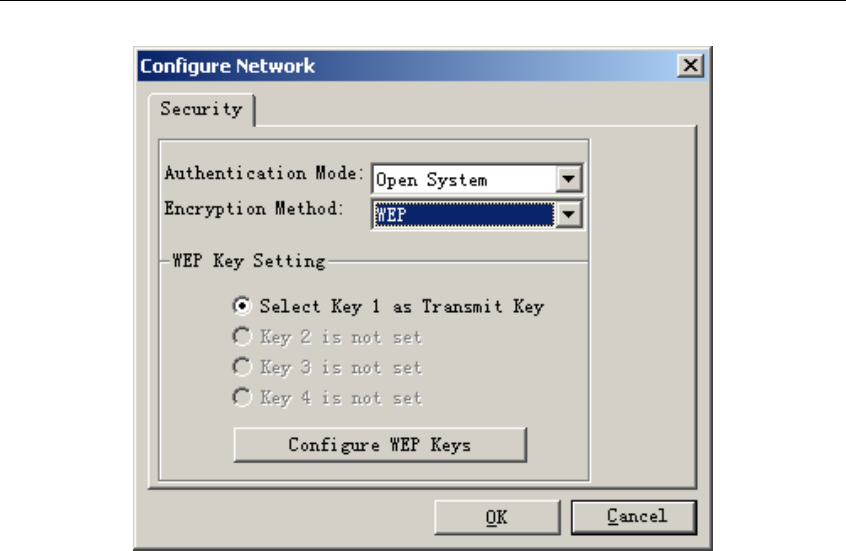
Wireless network adapter User manual
Page 19 of 27
Figure 6-3
Choose the Authorization modes and Encryption modes in the drop-down box. If the wireless network
uses a Passphrase, enter the Passphrase in the Passphrase field. If the wireless network uses a WEP
key, enter the WEP key in the Key field.
Click the OK button to complete the network connection and return to the Site Survey screen, or click
the Cancel button the cancel the network connection and return to the Site Survey screen.
6.3 Admin
The Admin tab screen (Figure 6-4) lets you import or export profiles.
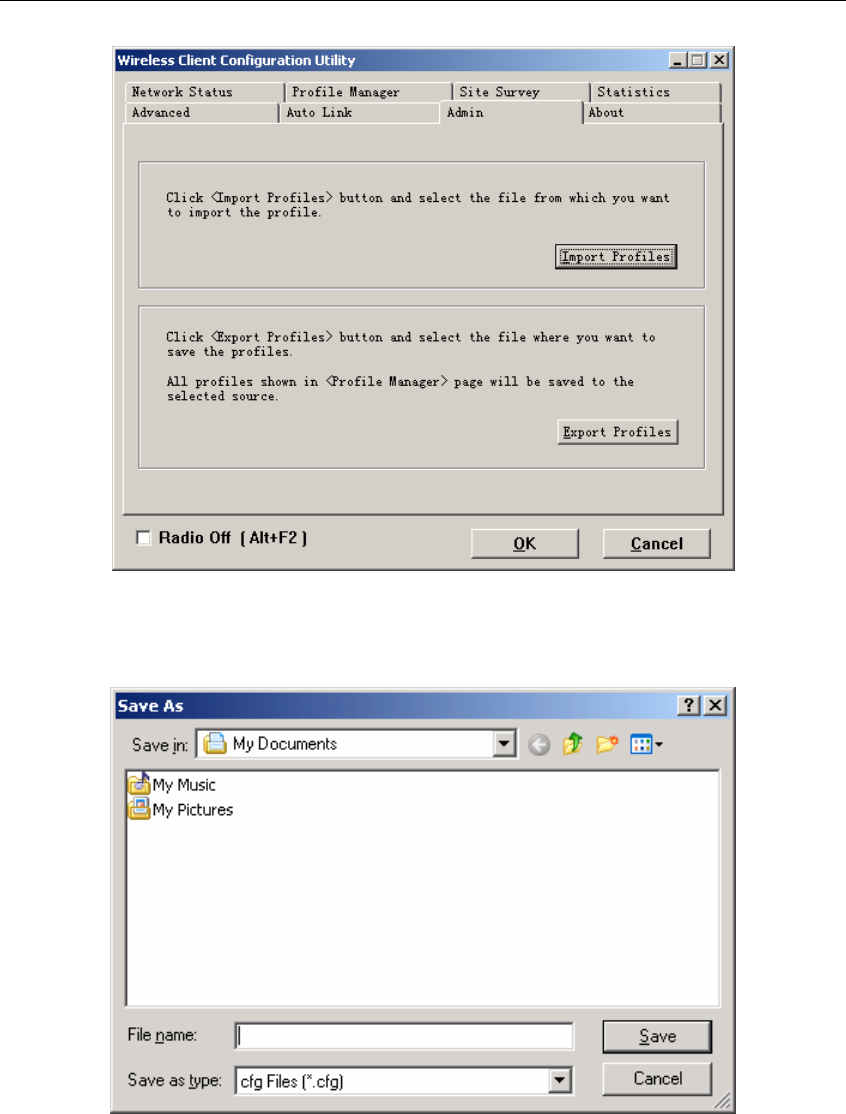
Wireless network adapter User manual
Page 20 of 27
Figure 6-4
Export Profile
To save the profile(s) in a different location, click the Export Profile button. On the screen that appear
(Figure 6-5), direct Windows to the appropriate folder and click the OK button.
Figure 6-5
Import profile
Click the Import Profile button to import a profile that has been saved in another location. From the
screen that appears (shown in Figure 6-6), select the appropriate file, and click the Open button.
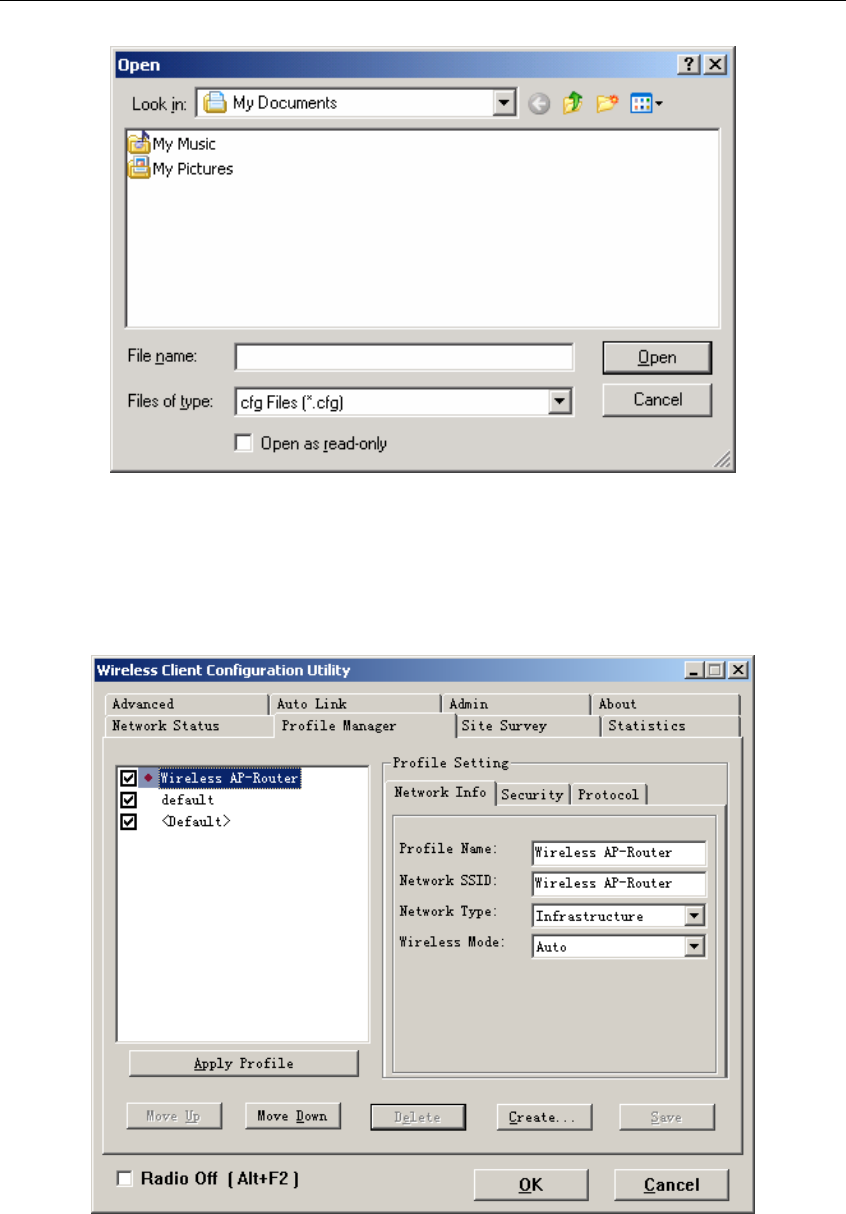
Wireless network adapter User manual
Page 21 of 27
Figure 6-6
6.4 Profile Manager
Figure 6-7
On the Profile Manager tab, shown in Figure 6-7, click the Create button to create a new profile.
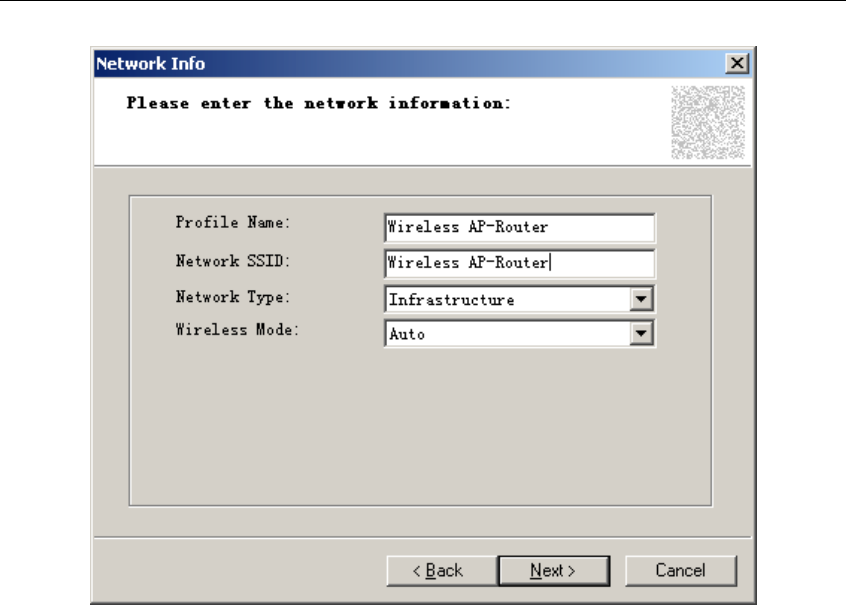
Wireless network adapter User manual
Page 22 of 27
Figure 6-8
When the Network Info screen appears (Figure 6-8), enter a name for the new profile. Enter the
Network SSID. Choose the Infrastructure Mode in the Network Type drop-down box if you want
your wireless computers to communicate with computers on your wired network via a wireless access
point. Choose the Ad-Hoc Mode in the Network Type drop-down box if you want multiple wireless
computers to communicate directly with each other. Click the Next button to continue or the Back
button to return to the previous screen.
Ad-Hoc Mode
If you choose Ad-Hoc Mode, select the Wireless Mode from the drop-down menu. Then, select the
correct operating channel for your network form the Prefer Channel drop-down menu. Click the
Next button.
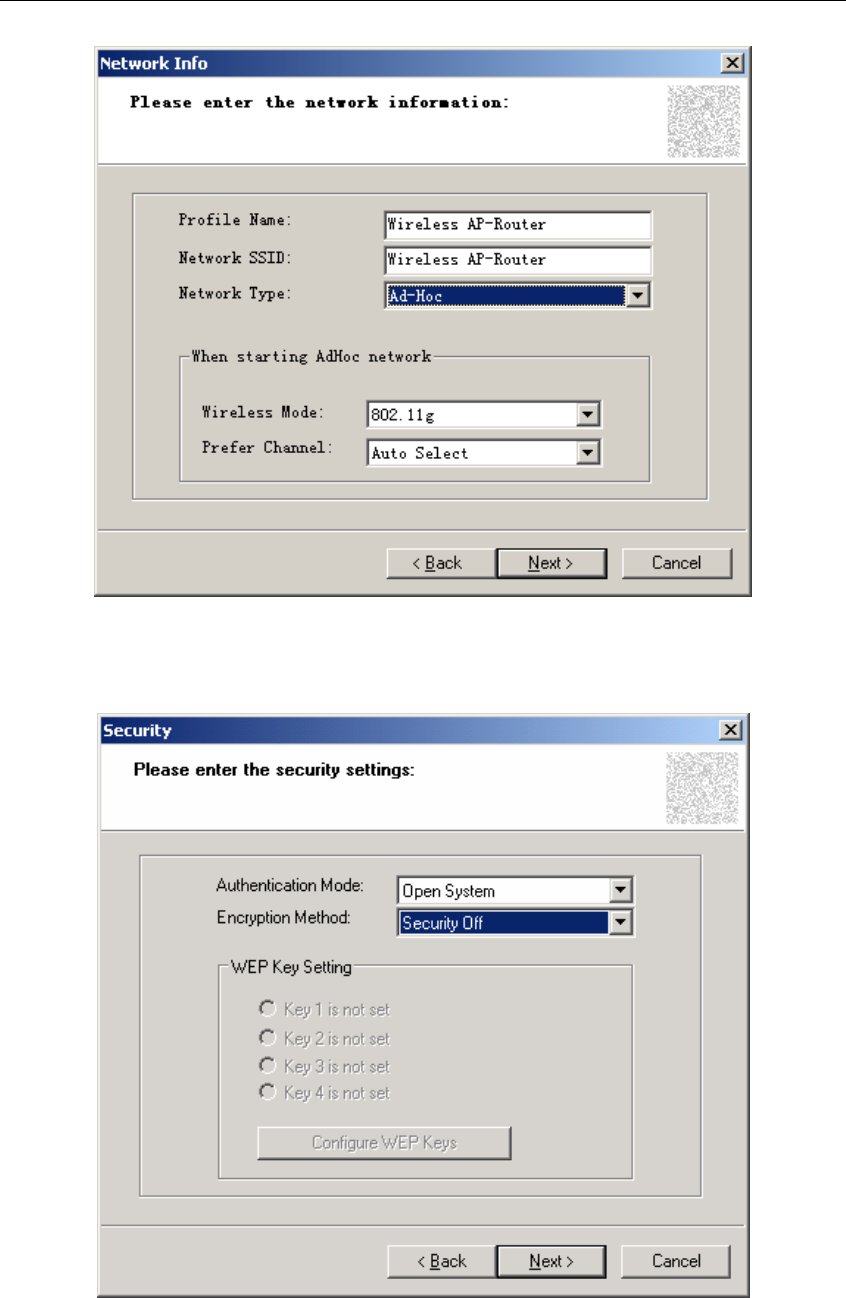
Wireless network adapter User manual
Page 23 of 27
Figure 6-9
Infrastructure Mode
If you choose Infrastructure Mode, click the Next button.
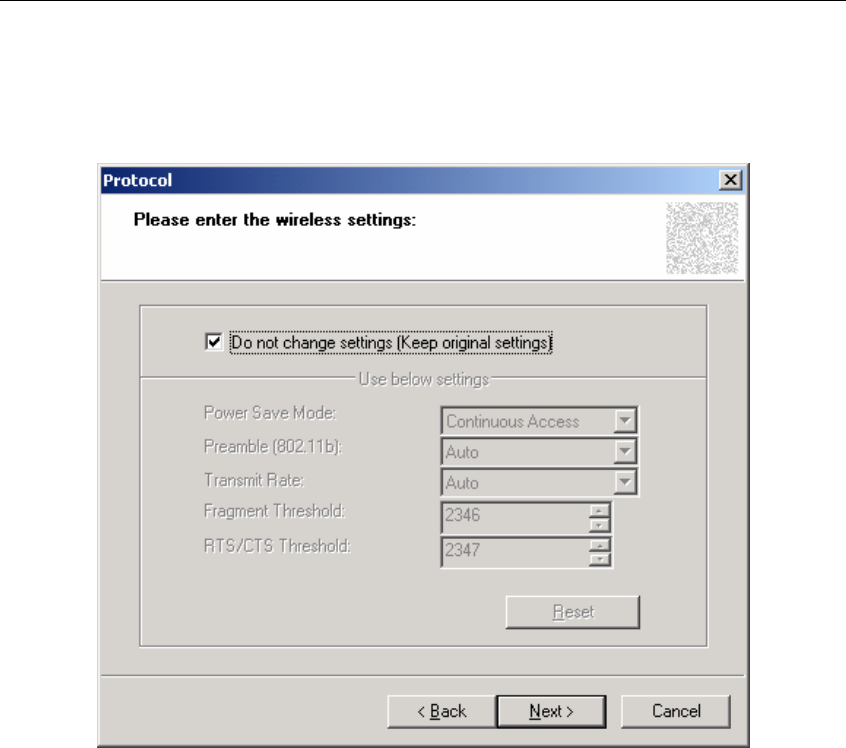
Wireless network adapter User manual
Page 24 of 27
Figure 6-10
The Security screen (Figure 6-10) will appear. Choose the Authentication Mode and Encryption
Method from the drop-down menu. To use WEP encryption (recommended to increase network
security), select 64 bits or 128 bits WEP from the drop-down menu, and enter either a Passphrase or
WEP key. Then click Next button.
Figure 6-11
The Protocol screen will appear. Select Do not change settings, then, click Next button.
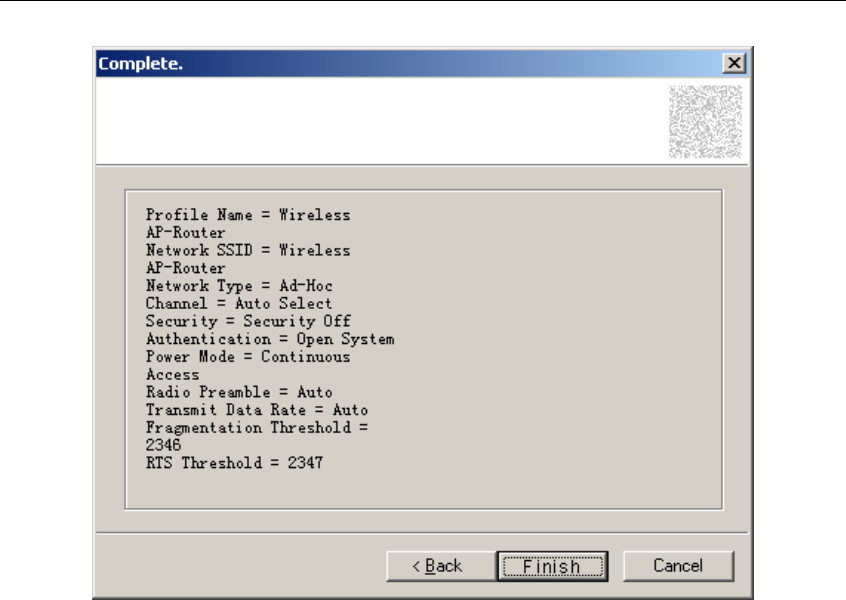
Wireless network adapter User manual
Page 25 of 27
Figure 6-12
The Complete Screen will appear. Click Finish button.
You have successfully created a connection profile.
Chapter 7 Troubleshooting
This chapter provides solutions to problems that may occur during the installation and operation of the
Wireless Cardbus/PCI Adapter. Read the descriptions below to solve your problems.
1. The Wireless Cardbus/PCI Adapter does not work properly.
z Reinsert the Wireless Cardbus/PCI Adapter into your PC’s PCI slot/Cardbus slot.
z Right click on My Computer and select Properties. Select the device manager and click on
the Network Adapter. You will find the Adapter if it is installed successfully. If you see the
yellow exclamation mark, the resources are conflicting. You will see the status of the
Adapter. If there is a yellow question mark, please check the following:
z Make sure that your PC has a free IRQ (Interrupt ReQuest, a hardware interrupt on a PC.)
z Make sure that you have inserted the right adapter and installed the proper driver. If the
Adapter does not function after attempting the above steps, remove the adapter and do the
following:
z Uninstall the driver software from your PC.
z Restart your PC and repeat the hardware and software installation as specified in this User
Guide.

Wireless network adapter User manual
Page 26 of 27
2. I cannot communicate with the other computers linked via Ethernet in the Infrastructure
configuration.
z Make sure that the PC to which the Adapter is associated is powered on.
z Make sure that your Adapter is configured on the same channel and with the same security
options as with the other computers in the Infrastructure configuration.
3. What should I do when the computer with the Adapter installed is unable to connect to the
wireless network and/or the Internet?
z Check that the LED indicators for the broadband modem are indicating normal activity. If
not, there may be a problem with the broadband connection.
z Check that the LED indicators on the wireless router are functioning properly. If not,
check that the AC power and Ethernet cables are firmly connected.
z Check that the IP address, subnet mask, gateway, and DNS settings are correctly
entered for the network.
z In Infrastructure mode, make sure the same Service Set Identifier (SSID) is specified
on the settings for the wireless clients and access points.
z In Ad-Hoc mode, both wireless clients will need to have the same SSID. Please note that
it might be necessary to set up one client to establish a BSS (Basic Service Set) and
wait briefly before setting up other clients. This prevents several clients from trying to
establish a BSS at the same time, which can result in multiple singular BSSs being
established, rather than a single BSS with multiple clients associated to it.
z Check that the Network Connection for the wireless client is configured properly.
z If Security is enabled, make sure that the correct encryption keys are entered on both the
Adapter and the access point.
APPENDIX A Specifications
Standards: IEEE 802.11g, IEEE 802.11b
Modulation: 802.11b: CCK (11 Mbps), DQPSK (2 Mbps), DBPSK (1 Mbps); 802.11g:
OFDM
Channels:
11 Channels (USA)
13 Channels (Europe)
14 Channels (Japan)
Network Protocol: TCP/IP, IPX, NDIS 4, NDIS 5, NDIS 5.1, NetBEUI
Interface: Cardbus/PCI
Transmit Power: 13 dBm
Sensitivity: -80 dBm
LED: PWR, LNK/ACT
WEP Key Bits: 64-Bit and 128-Bit
Dimensions: Cardbus: 118.3×5×54.5mm
PCI: 120×40mm (Non-Bracket)
Unit Weight: Cardbus: 55g
PCI: 50g
Power: Cardbus: 3.3V
PCI: 5V

Wireless network adapter User manual
Page 27 of 27
Certifications: FCC CE
Operating Temp.: 0ºC to 40ºC
Storage Temp.: -20ºC to 70º C
Operating Humidity: 10% to 85%, Non-Condensing
Storage Humidity: 5% to 90%, Non-Condensing